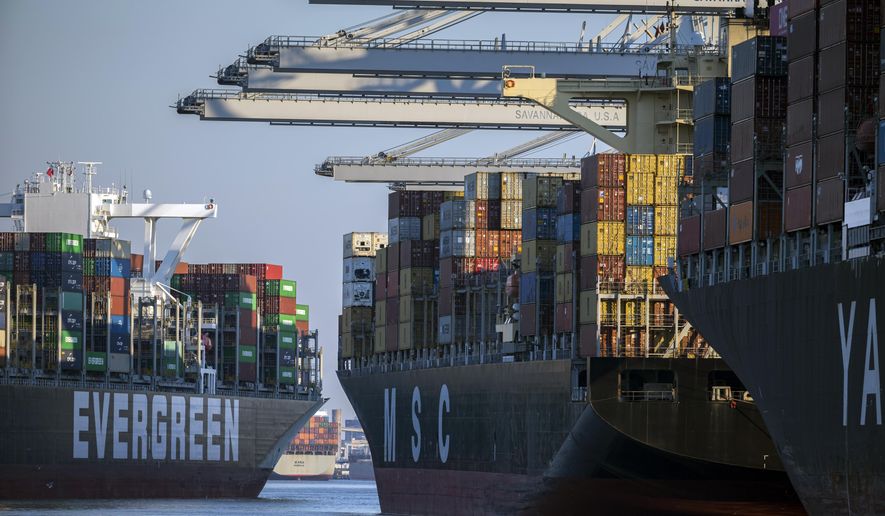President-elect Donald Trump’s victory has companies and countries scrambling to avoid looming tariffs on goods imported into the U.S.
Mr. Trump made no secret of plans to impose levies on goods from other nations, including a 60% tariff on products made in China.
Companies are rethinking their supply lines and, in some cases, foreign countries are plotting ways to fight back or mollify the incoming U.S. leader.
Shoe company Steven Madden said it would slash its China-based production by up to 45%, given Mr. Trump’s plans to single out the Asian superpower.
The company will not move those operations to the U.S., instead shifting to places like Cambodia, Vietnam, Mexico and Brazil.
“We have been planning for a potential scenario in which we would have to move goods out of China more quickly,” Steven Madden’s CEO Edward Rosenfeld told investors on an earnings call days after the election. “We are putting that plan into motion.”
SEE ALSO: Some in Southeast Asia see a definite upside to Trump’s return to power
It’s not just China. Economic analysts say other countries, including Asian trading partners that see an uptick in production from companies fleeing China, could be targeted for tariffs because of Mr. Trump’s distaste for trade deficits.
Foreign officials will consider whether to pass countermeasures or cut deals with Mr. Trump to avoid a full-on trade war. Europe might opt to increase its imports of U.S. goods, such as liquefied natural gas or agricultural products, to avoid high U.S. tariffs on its exports.
“The E.U. will be keen to avoid tariffs completely and may offer concessions on economic or political issues to limit the tariff threat,” Andrew Kenningham, chief Europe economist at Capital Economics, wrote in a Friday note.
Tariffs are a form of tax or duty that is paid on imports.
Mr. Trump says tariffs will force companies to keep their operations in the U.S. and employ American workers while creating revenue to fund domestic programs. The U.S. relied on tariffs as a primary source of government revenue until the federal income tax was imposed in the early 20th century.
Mr. Trump calls tariffs “the greatest thing ever invented” and sees them as a bargaining chip with foreign nations to influence policy or prevent wars.
During his first term, Mr. Trump slapped tariffs on Chinese goods and imports like steel and solar panels. The Biden administration kept some Trump-era tariffs, including $360 billion on Chinese goods and a 100% levy on electric vehicles made in China.
Yet Mr. Trump wants to go much further in his second term, including a threat to put a 20% tariff on Mexican goods if President Claudia Sheinbaum does not stop the flow migrants crossing the southern U.S. border illegally.
Mr. Trump threatened to slap a 200% tariff on John Deere, the agricultural machinery maker, if it moves operations to Mexico and tries to export those products back to the U.S.
“The American people reelected President Trump by a resounding margin giving him a mandate to implement the promises he made on the campaign trail. He will deliver,” said Karoline Leavitt, a transition spokeswoman for Mr. Trump and Vice President-elect J.D. Vance.
It is unclear whether Mr. Trump has the authority to impose sweeping tariffs on his own. Experts say he can cite national security and other provisions in the law to impose tariffs, though lawmakers might have to approve sweeping measures.
“The tariffs, that most likely is going to require 60 [Senate votes] unless there’s some way we can get that done through reconciliation with 51,” Sen. Rick Scott, a Florida Republican running for majority leader, said on Fox News’ “Sunday Morning Futures.”
Mr. Scott was referring to a fast-track budget maneuver the incoming GOP majority can use to avoid a Democratic filibuster.
Mr. Trump’s tariff plan will enthuse those who say protectionist policies will shield domestic industries and help workers, though many economists and business groups are worried.
While tariffs hurt foreign countries by making their products more expensive and harder to sell in the U.S., foreign countries don’t pay the tariffs directly to the U.S. Treasury. Companies in the U.S. pay the levies and decide whether to pass along the cost to consumers in the form of higher prices.
The National Retail Federation estimates new tariffs could increase consumer prices by $46 billion to $78 billion each year.
Mr. Trump’s opponent, Vice President Kamala Harris, decried Mr. Trump’s tariff plans as a tax on lower-income Americans, and an analysis by the Peterson Institute for International Economics said the tariff plans would cost the average middle-income household at least $1,700 annually.
On the campaign trail, Mr. Trump told supporters that tariffs are “not going to be a cost to you, it’s a cost to another country.”
Beyond raising prices, companies can respond to the tariff threat by stockpiling goods in the short term or shifting around their operations or suppliers, said Jake Colvin, the president of the National Foreign Trade Council.
He said companies should also consider the impact of tariffs on employment, as higher costs can impact workforce decisions.
“Ultimately, it’s going to be important for the administration to make clear the pathways it intends to pursue but, until that clarity comes, businesses will have to plan for a variety of scenarios,” Mr. Colvin said. “Most companies likely won’t be starting their planning processes from scratch, having navigated supply chain disruptions from the pandemic and the Biden and Trump administrations’ increased use of tariffs and national security controls over the past eight years.”
Mr. Rosenfeld, at Steven Madden, said the company does about two-thirds of its business through imports, and 70% of that is done through China. That’s about to change.
“A year from today,” he said, “we would be looking at just over one-fourth of our business that would be subject to potential tariffs on Chinese goods.”
• Tom Howell Jr. can be reached at thowell@washingtontimes.com.




Please read our comment policy before commenting.